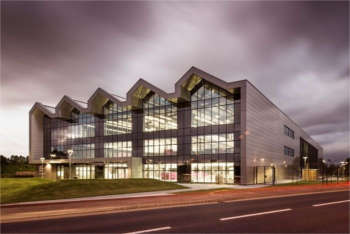Transport-led projects in the British rust belt need to foster cross-sector initiatives such as educational opportunities, a new report from one of the UK's largest transport groups has argued.
The Urban Transport Group, which represents Britain's largest urban areas, has argued that one-off capital projects are 'unlikely to be enough in themselves for towns to thrive'.
It cites the creation of a new multi-modal transport interchange in Altrincham, Greater Manchester, which together with other investment, led to a 19% increase in town centre footfall and a 20% reduction in vacancy rates.

National College for High Speed Rail, Doncaster
About towns: How transport can help towns thrive, looks at British urban areas where historic industries have fallen into decline - dubbed 'post-industrial towns'.
It argues investment needs 'to be part of wider and coordinated packages of transport measures which in turn are integrated with cross-sector initiatives in areas like education, housing and economic development (such as locating new colleges alongside public transport hubs and ensuring public transport is affordable for young people)'.
Jonathan Bray, director of the Urban Transport Group, added: 'We need to move away from a ‘silver bullet’ approach based on a single transport solution and instead towards packages of transport measures combined with wider cross-sector initiatives on housing, employment and education. Only then can transport make its mark in reversing the fortunes of our post-industrial towns.'
Key findings:
- The transport sector is a major employer in towns and can be both an anchor institution (reinvesting in local businesses) and an exemplary employer (by investing in skills and people, and by paying decent wages).
- Hard and soft (capital and revenue) transport measures can play a vital role in widening access to employment, education and skills, enhancing quality of life, and enabling access to leisure, recreation and physical activity for the residents of towns.
- Transport is key to opening up new sites for housing and commercial development in and around towns.
The report also provides case studies of where transport infrastructure has helped spark urban renewal. Examples include:
- The transformation of Kilmarnock Station, in Scotland, into a vibrant hub for the community;
- The new National College for High Speed Rail’s £25m campus in Doncaster, catering for over 1,000 students a year. This builds on Doncaster’s rich railway heritage and acts as a potential anchor institution, reinvesting in the town’s rail businesses
The report's findings chime with recent comments made by Sir John Armitt, chair of the National Infrastructure Commission, who suggested a further £43bn should be spent on schemes beyond HS2 to improve links in big cities and 'make the most' of the project.
He warned it was not enough to 'simply construct a new high-speed rail line and leave it at that'.
Register now for full access
Register just once to get unrestricted, real-time coverage of the issues and challenges facing UK transport and highways engineers.
Full website content includes the latest news, exclusive commentary from leading industry figures and detailed topical analysis of the highways, transportation, environment and place-shaping sectors.
Use the link below to register your details for full, free access.
Already a registered? Login